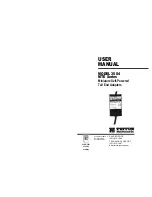
Network Adapter Card Installation Guide
191
If possible, use another twisted pair or fiber optic cable to connect the
network adapter card to the remote device. If this resolves the
problem, replace the failed cable.
For a dual port card, verify that only one port is connected to the
network.
Run the AT-Diag utility and perform the Diagnostics Test to test the
network adapter card’s components. For instructions, refer to Chapter
10, “AT-Diag Utility” on page 175.
Power off the system and check to be sure that the network adapter
card is securely installed in the PCI bus. You might try installing the
network adapter card in a different PCI bus in the system to eliminate
the possibility of a problem with the PCI connector on the system’s
motherboard.
The LEDs indicate the presence of a link between the port on the network
adapter card and the remote device, but the network adapter card is not
receiving or forwarding network traffic or performance is slow or
intermittent:
For a dual port network adapter card, check to be sure that only one
port is connected to the network.
For a twisted pair port operating at 100 Mbps, check to be sure you are
using Category 5 or higher twisted pair cable. Category 3 cabling is
sufficient for 10 Mbps operation, but can cause problems at 100 Mbps.
For a fiber optic port, use a fiber optic tester to measure signal
attenuation. If signal strength is too low, you have either exceeded the
permitted maximum length of the fiber optic port or the fiber optic cable
has a problem, such as too many splices. Refer to Chapter 1, “Network
Adapter Card Overview” on page 13 for operating specifications of the
fiber optic ports.
For a twisted pair port, check the operating speed and duplex mode of
the port on the remote device by referring to the device’s
documentation. If the device has management firmware, use the
firmware to examine the port’s operating settings. All of the adapters
discussed in this guide have a default setting of Auto-Negotiation for
the twisted pair port. If the port on the remote device does not feature
Auto-Negotiation and has a fixed duplex mode of full-duplex, you must
manually configure the speed and duplex mode of the adapter’s port to
avoid a duplex mode mismatch, which can impact performance. A
twisted pair port operating in Auto-Negotiation will default to the half-
duplex mode when connected to a device that is not using Auto-
Negotiation. This results in a duplex mode mismatch if the second
device is operating at full-duplex. To configure the port, you can use
the AT-Diag utility, explained in Chapter 10 on page 175 or, if the
system is running Microsoft Windows 2000, 2003, or XP, you can
perform the procedure “Configuring the Network Adapter Card
Settings” on page 91.
Summary of Contents for AT-2450FTX
Page 8: ...Contents 8 ...
Page 44: ...Chapter 1 Network Adapter Card Overview 44 ...
Page 56: ...Chapter 2 Installing a Network Adapter Card 56 ...
Page 106: ...Chapter 3 Microsoft Windows 2000 2003 and XP 106 ...
Page 116: ...The Network window is shown in Figure 71 Figure 71 Network Window ...
Page 124: ...Chapter 5 Novell Netware 6 5 124 ...
Page 156: ...Chapter 8 AT Stat Utility 156 ...
Page 174: ...Chapter 9 AT MUX Multiple VLAN Protocol 174 ...
Page 180: ...Chapter 10 AT Diag Utility 180 Figure 111 Loopback Connector ...
Page 188: ...Chapter 10 AT Diag Utility 188 ...
Page 208: ...Appendix D Cleaning Fiber Optic Connectors 208 ...
Page 234: ...Appendix E Translated Safety Statements 234 ...
Page 238: ...Index 238 ...
















































